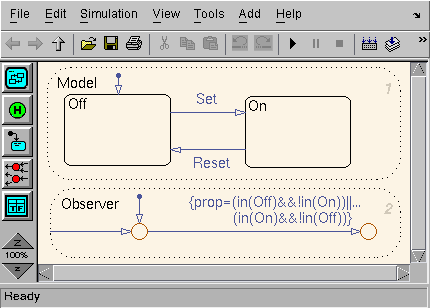
Figure 5: A Stateflow chart with an observer node



% sf2lus -names -states_visible SetReset_r13.mdl -o SetReset_r13.lus \ -observe "((sOn and not sOff) or (sOff and not sOn))"This will result in the following node being appended to the Lustre output:
-- observer for expr: ((sOn and not sOff) or (sOff and not sOn)) node verif_2_1(Set, Reset: event) returns(prop: bool); var x: int; let x = sf_2(Set, Reset); prop = ((sOn and not sOff) or (sOff and not sOn)); telThe name of the observer node is
verif_<CID>_<index> where <CID>
is the chart id as before and <index> is a unique index for the
observer (verif becomes verify under -long_names).
This can then be passed to Lesar for checking:
% lesar SetReset_r13.lus verif_2_1 -v -diag --Pollux Version 2.1 start normalisation ... done start minimal network generation ..... done (90 -> 64 nodes) building bdds ... 6 (on 6) computing relevant statevars ... done (3 on 3) DONE => 3 states 5 transitions =>total bdd memory : 59 nodes (~ 5.99 K) TRUE PROPERTYIn fact the process can be automated somewhat since the translator automatically looks for an observer file when a model file is translated. This file has the same name as the model file but with
.mdl replaced by
.obs.
The format of this file is simply one observer per line with blank lines
and Lustre-style comments (starting with --) ignored.
This behaviour can be switched off using the -no_observers option.Figure 5 shows a Stateflow chart (SetResetV.mdl) with an observer implemented in Stateflow. If a toplevel node called ``Observer'' exists in the chart with a boolean output called ``prop'' (or ``property'' with
Figure 5: A Stateflow chart with an observer node
-long_names) then a Lustre observer node for prop is
automatically appended to the translated output.
We can thus use all of Stateflow's action language to build observers which
means that the designer does not have to learn Lustre and that the observed
property is visible in the Stateflow chart.Consider the chart in Figure 6 (Parallel6V.mdl). This contains two copies of a subchart with parallel states which are identical apart from the order in which the parallel states are visited. The observer simply compares, state by state, the two parallel machines. If we translate the chart into Lustre and run Lesar on it:
Figure 6: An observer for parallel state confluence
% sf2lus Parallel6V.mdl -o Parallel6V.lus -names -states_visible % lesar Parallel6V.lus verif_2_1 --Pollux Version 2.1 TRUE PROPERTYWe get a TRUE property showing that the two versions of the subchart are indeed equivalent and thus their parallel states are confluent.
% sf2lus Parallel6_12.mdl -o Parallel6_12A.lus -prefix A -names -states_visible % sf2lus Parallel6_21.mdl -o Parallel6_21B.lus -prefix B -names -states_visibleThis allows a comparative observer to be built in Lustre, as follows:
include "Parallel6_12A.lus";
include "Parallel6_21B.lus";
node verif(S1, R1, S2, R2: bool) returns(prop: bool)
AsgN1, AsB, AsA, AsgN2, AsD, AsC,
BsgN1, BsB, BsA, BsgN2, BsD, BsC: bool;
let
AsC, AsD, AsA, AsB, AsgN2, AsgN1 = Asf_2 (S1, R1, S2, R2);
BsA, BsB, BsC, BsD, BsgN1, BsgN2 = Bsf_2 (S1, R1, S2, R2);
prop = AsgN1 = BsgN1 and AsgN2 = BsgN2 and
AsA = BsA and AsB = BsB and
AsC = BsC and AsD = BsD;
tel
This simply includes both versions of the chart with alternate parallel state
order and compares the outputs.
The strange ordering of the output variables is due to the fact that inputs and
outputs are indexed according to the id numbers of the data, events,
states and junctions.
Stateflow orders these according to its internal priorities.err (or
error in -long_names format) which is set to true if
there is an attempt to broadcast an event at the lowest level of the event
stack.
Consider again the chart in Figure 2.
If we translate the chart with an event stack of 1 and run Lesar on the output:
% sf2lus Events3.mdl -o Events3.lus -errstate -ess 1 % lesar Events3.lus verif_2_1 --Pollux Version 2.1 FALSE PROPERTYWe get a FALSE property because we tried to broadcast the F output event while processing the E event at level 1 of the event stack. For this chart we actually need an event stack of 2:
% sf2lus Events3.mdl -o Events3.lus -errstate -ess 2 % lesar Events3.lus verif_2_1 --Pollux Version 2.1 TRUE PROPERTYBeware, however, that the
-errstate variable is not set if you do not
define an event stack, a false positive will result.
The sf2lus translator assumes that you know the chart is confluent if you do
not use an event stack.-consistency option triggers the generation of just such an observer
(called consistency_<CID>).
-- Observer for state consistency
node consistency_2(E: event) returns(prop: bool);
var y, x, z: real; sB, sC, sA, sE, sD, sgTop2, sgTop1: bool;
let
y, x, z, sB, sC, sA, sE, sD, sgTop2, sgTop1 = sf_2(E);
prop =
((sgTop1 and sgTop2) and
(if sgTop1
then ((sD and ((not sE) and (not sA))) or
(((not sD) and (sE and (not sA))) or
((not sD) and ((not sE) and sA))))
else (not (sD or (sE or sA))) and
if sgTop2 then ((sC and (not sB)) or ((not sC) and sB))
else (not (sC or sB))));
tel
Observers for junction entry counters are discussed in Section 4.2.

